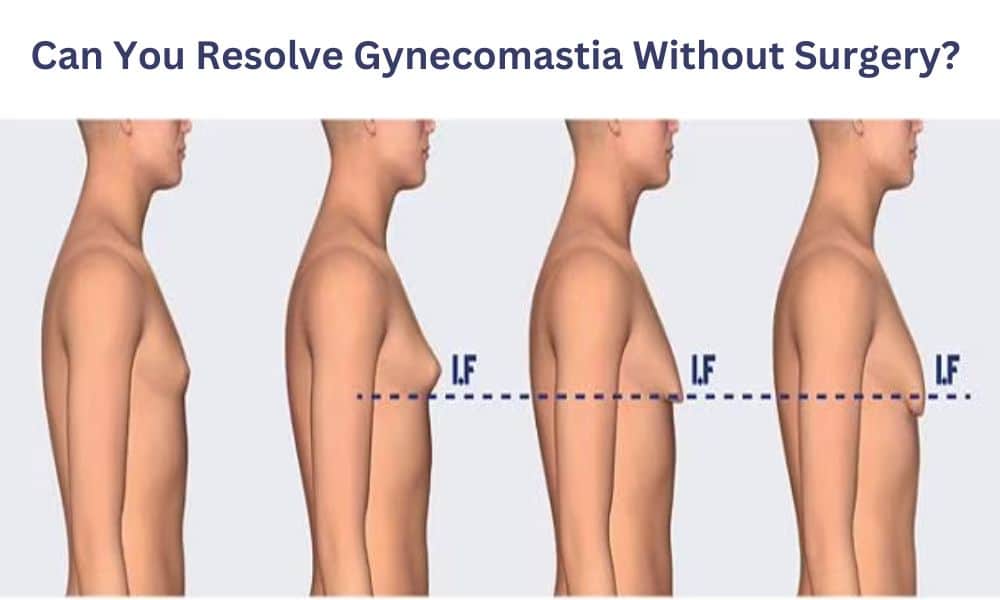Gynecomastia, the enlargement of male breast tissue, is a condition that can cause significant physical and emotional discomfort. While surgery is often seen as a definitive solution, many men seek non-surgical methods to address the issue. This blog explores various non-surgical options for managing and potentially resolving gynecomastia.
1 – “Lifestyle Changes” Is A Foundational Approach
One of the first steps to addressing gynecomastia without surgery is making certain lifestyle changes. These changes can sometimes be enough to reduce the appearance of gynecomastia, particularly if the condition is related to obesity or poor overall health.
- Weight Loss and Exercise: For many men, gynecomastia is linked to excess body fat. By adopting a healthy diet and regular exercise routine, it’s possible to reduce overall body fat, which may also decrease the size of the breasts. Cardio exercises such as running, cycling, and swimming, combined with strength training, particularly exercises targeting the chest area (like push-ups and bench presses), can help tone the chest and reduce the fatty tissue.
- Dietary Adjustments: A diet low in processed foods, sugars, and unhealthy fats, and rich in whole foods like vegetables, fruits, lean proteins, and healthy fats, can support weight loss and hormonal balance. Reducing alcohol intake and avoiding drugs known to contribute to gynecomastia, such as anabolic steroids and certain medications, can also be beneficial.
- Avoiding Triggers: Some substances, such as certain medications, illegal drugs, and even specific herbal supplements (like tea tree oil and lavender), have been linked to hormone imbalances that could contribute to gynecomastia. Identifying and avoiding these triggers can help in managing the condition.
2 – Medical Treatments As Hormonal and Pharmacological Solutions
When lifestyle changes aren’t sufficient, medical treatments may be considered. These typically involve hormone regulation or the use of specific medications to address the underlying causes of gynecomastia.
- Hormone Therapy: Gynecomastia can sometimes be caused by an imbalance between estrogen and testosterone levels. In such cases, hormone therapy might be prescribed to correct the imbalance. Testosterone replacement therapy (TRT) is one option that can help reduce the effects of gynecomastia, particularly in older men with low testosterone levels.
- Medications: There are medications specifically designed to treat gynecomastia. Some of the commonly used drugs include:
- Selective Estrogen Receptor Modulators (SERMs): Drugs like tamoxifen and raloxifene can help reduce breast tissue size in men by blocking the effects of estrogen.
- Aromatase Inhibitors: Medications such as anastrozole and letrozole reduce the conversion of testosterone into estrogen, potentially helping to reduce breast tissue growth.
- Clomiphene: This medication can increase testosterone production while reducing estrogen levels, helping to restore a better hormonal balance.
It’s important to note that these medications should only be taken under the guidance of a healthcare professional, as they can have side effects and may not be suitable for everyone.
3 – Compression Garments Serve As A Non-Invasive Quick Fix
While not a solution to gynecomastia, compression garments can effectively manage the condition’s appearance. These garments, often referred to as gynecomastia vests or shirts, are designed to flatten the chest and provide a more typical male contour.
- Benefits: Compression garments are a non-invasive option that can instantly improve the appearance of gynecomastia, offering a confidence boost for men uncomfortable with their chest’s appearance in certain clothing.
- Limitations: It’s essential to understand that these garments only mask the problem; they do not treat the underlying condition. They are best used as a temporary measure or in conjunction with other treatments.
4 – Non-Surgical Medical Procedures & Emerging Technologies
In recent years, non-surgical procedures have gained popularity as potential treatments for gynecomastia. These methods, while still requiring medical intervention, offer an alternative to traditional surgery.
- CoolSculpting (Cryolipolysis): CoolSculpting is a non-invasive fat reduction procedure that uses controlled cooling to target and destroy fat cells in specific areas of the body, including the chest. While it’s primarily used for reducing fat rather than breast glandular tissue, it can be effective for men whose gynecomastia is primarily due to excess fatty tissue rather than glandular tissue.
- Ultrasound Therapy: High-intensity focused ultrasound (HIFU) is another non-invasive treatment that uses focused ultrasound waves to break down fat cells in the targeted area. While more research is needed to fully understand its effectiveness for gynecomastia, it shows promise as a non-surgical option.
- Laser Lipolysis: Laser lipolysis, also known as SmartLipo, is a minimally invasive procedure that uses laser energy to liquefy fat cells before they are removed from the body. It can be an effective method for reducing excess fatty tissue in the chest area, although it’s less effective for glandular tissue.
Psychological Support For Addressing Emotional Impact
While physical treatments are essential, it’s also important to consider the emotional and psychological impact of gynecomastia. For many men, the condition can lead to feelings of embarrassment, anxiety, and even depression. Seeking support from a mental health professional, joining support groups, or engaging in counseling can help address these issues.
Considering gynecomastia treatment without surgery in Lahore? At Dr. Atta Plastic Surgery in Lahore, we provide expert advice on managing gyno with non-surgical methods. If surgery is needed, we offer competitive gynecomastia surgery prices in Lahore with high-quality care. Explore your options and understand gynecomastia surgery costs with us!
Conclusion: Balancing Expectations and Realities
While non-surgical methods for resolving gynecomastia can be effective, it’s important to have realistic expectations. Lifestyle changes, medications, and non-invasive treatments can reduce the appearance of gynecomastia or manage its symptoms, but they may not completely eliminate the condition, especially in cases involving significant glandular tissue. Consulting with a healthcare professional is crucial to developing a treatment plan tailored to your needs, whether that involves non-surgical methods, surgery, or a combination of both.

